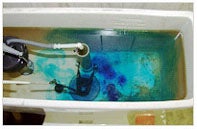Finding water leaks can save you water, which means saving money on water and sewer bills. Follow these easy steps to determine if you have a leak in a home, irrigation system or pool. Any leaks occurring after the meter on private property are the responsibility of the homeowner.
Follow our video tutorials and our step-by-step guides to learn more about leak detection and to self-diagnose any potential water leaks.
First, locate your meter box. It is generally located near the sidewalk in front of your home in a direct line with the main outside faucet. It's important to make sure the meter box lid is uncovered and visible at all times. A black circular disc on the lid provides the signal to the meter reader with an electronic signal - a 'radio read.'
Turn all water-using appliances off so that no water is being used. This means turning off all water inside and outside the house including showers, sinks, washing machines, ice makers and any appliance that uses water. If you have an automatic irrigation system, turn off the controller.
Carefully remove the meter box lid by using a tool such as a large screwdriver. Stand back. There are sometimes 'critters' inside the box that will be startled when the lid is removed. Give them a chance to get out of the way.
The meter uses a straight-reading dial which is read similar to a car's odometer. The meter measures water use in thousands of gallons.
Most meters in the City of Chandler have a digital display which alternates between the meter reading and the flow rate. Other meters have an analog, or dial type display that records water use.
For Digital Display (LCD) Meters
- Observe the flow rate screen for at least 10 flashes. If the number is greater than zero on any of the flashes, you have a continuous leak.
For Analog (dial) Display Meters
- Observe the sweep hand near the center of the meter. It should not move if you are not using any water inside or outside the home. Some meters also have a small pointer or dial known as the flow indicator. If the flow indicator is moving, you may have a leak.
- If there is no indicator and the actual meter dial hand is moving, water is running somewhere in your system and you have a leak, go to step 3.
- If the hand is not moving, note the position of the hand and wait 10 minutes. Check the meter again, if it has moved, you have a slow leak, go to step 3.
- If no movement is recorded, you probably don't have a leak. The meter may not be able to detect leaks in irrigation systems or pools.
To isolate the leak, turn the water off to your house. Your home's valve is usually located under the outside faucet near the front of the house. With all water turned off in the house, there should be no movement of the small pointer or any of the dials on the meter.
If the leak indicator or dial is still moving, water is flowing between the meter and the shut-off valve. That means you could have a leak between the meter and the valve where water enters your home. This is called the 'service line'.
Consider that movement in your meter can also be caused by things like an automatic pool filler, a leaky irrigation valve, or an evaporative cooler.
Check your irrigation system. If you have leaks in your irrigation system, they may not be noticeable unless your system is running. Turn your controller on manually and walk your property looking for broken sprinkler heads, missing emitters (which will produce small streams of water) or breaks in irrigation piping or tubing. Check for leaks inside the house including toilets, washing machines, faucets, etc.

To check a toilet for a leak: Add 2 or 3 drops of food coloring to the water in the reservoir or tank (as shown in photo). Wait 15-30 minutes. If the water in the bowl changes colors, the rubber flapper needs to be replaced. In leaky toilets, the flapper valve often needs to be replaced.
Congratulate yourself! You've just completed a leak-detection investigation.
If you need assistance in troubleshooting leaks, contact Water Conservation to schedule an appointment and/or to perform a free water audit.
If you have a leak at your water meter, contact Chandler water distribution at 480-782-3700.




